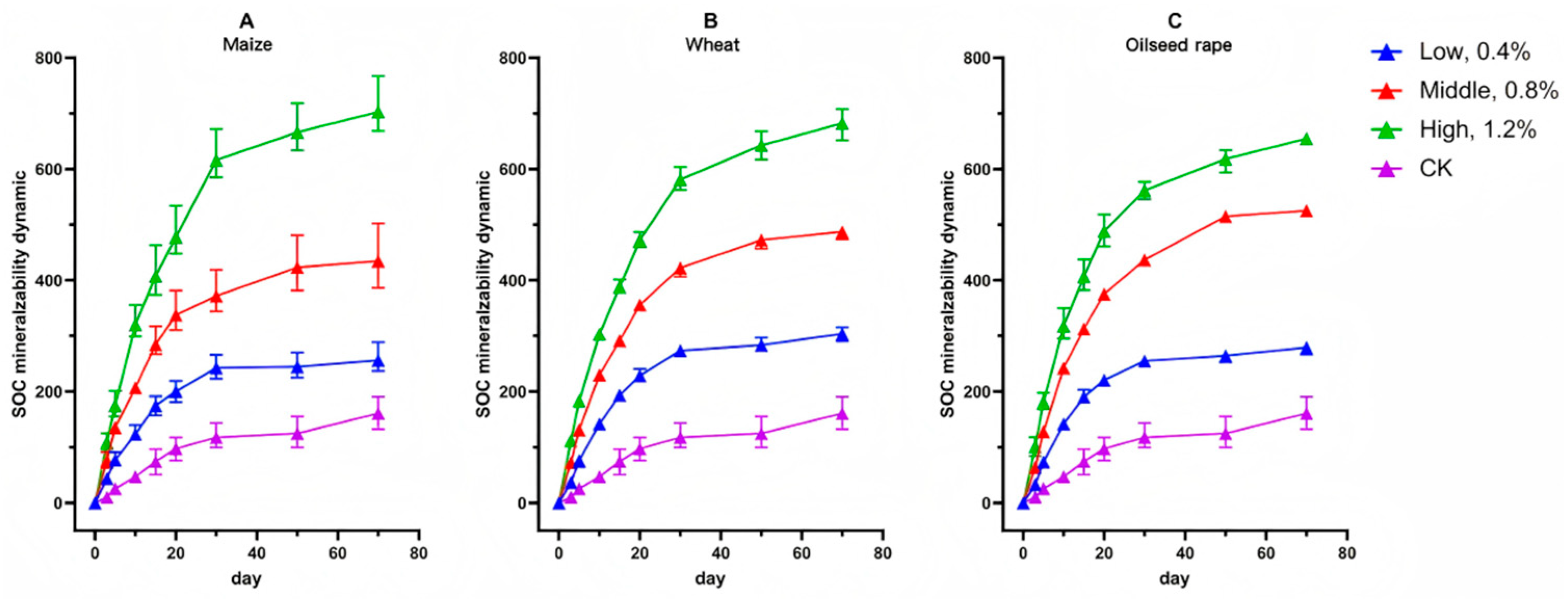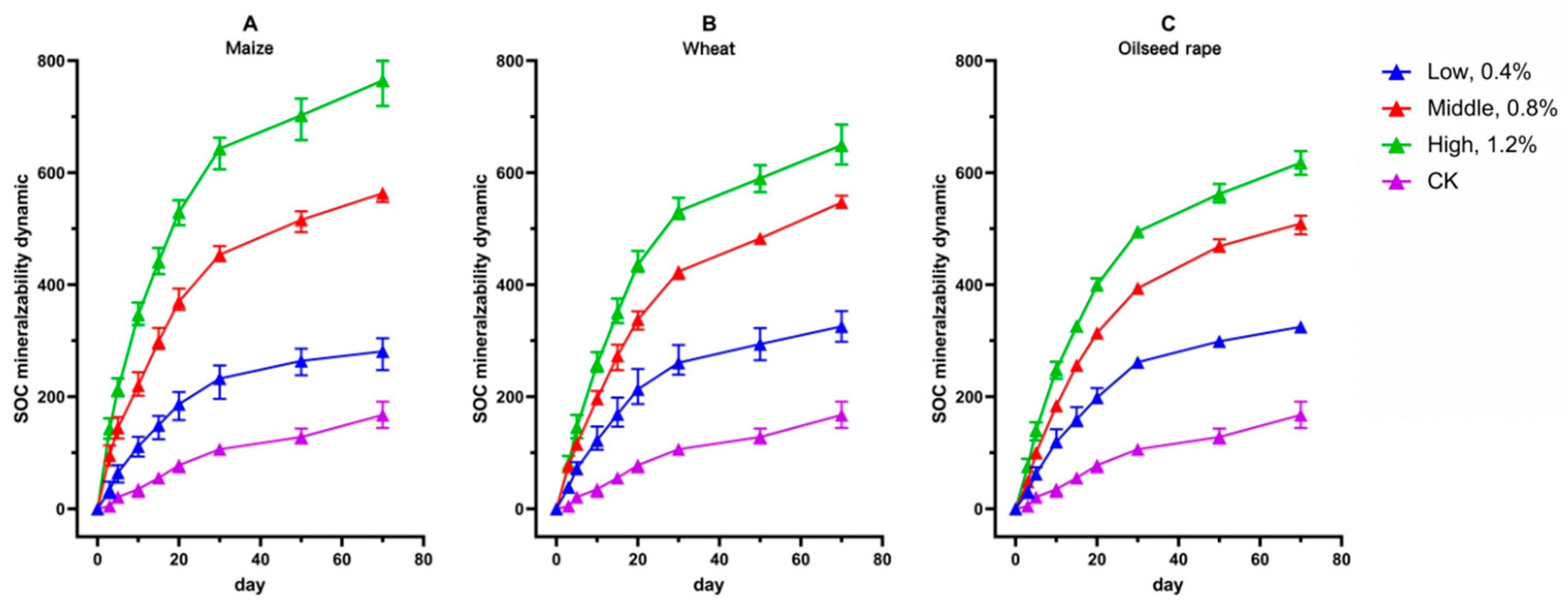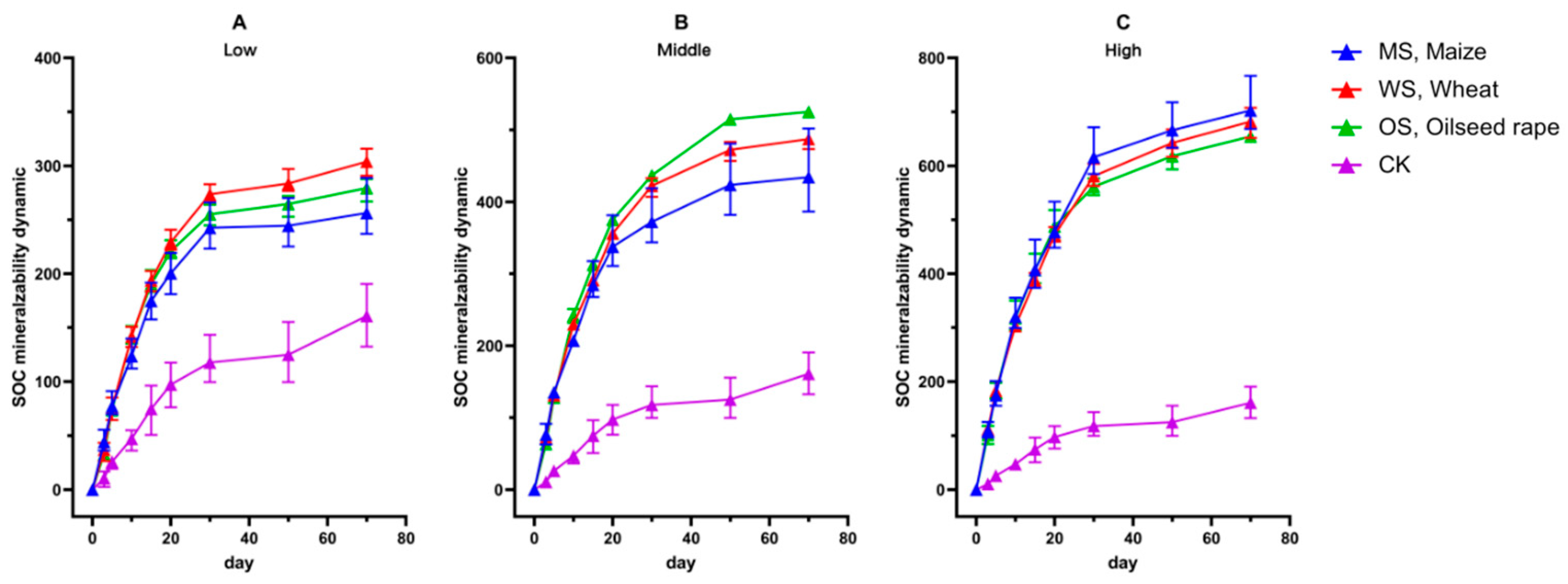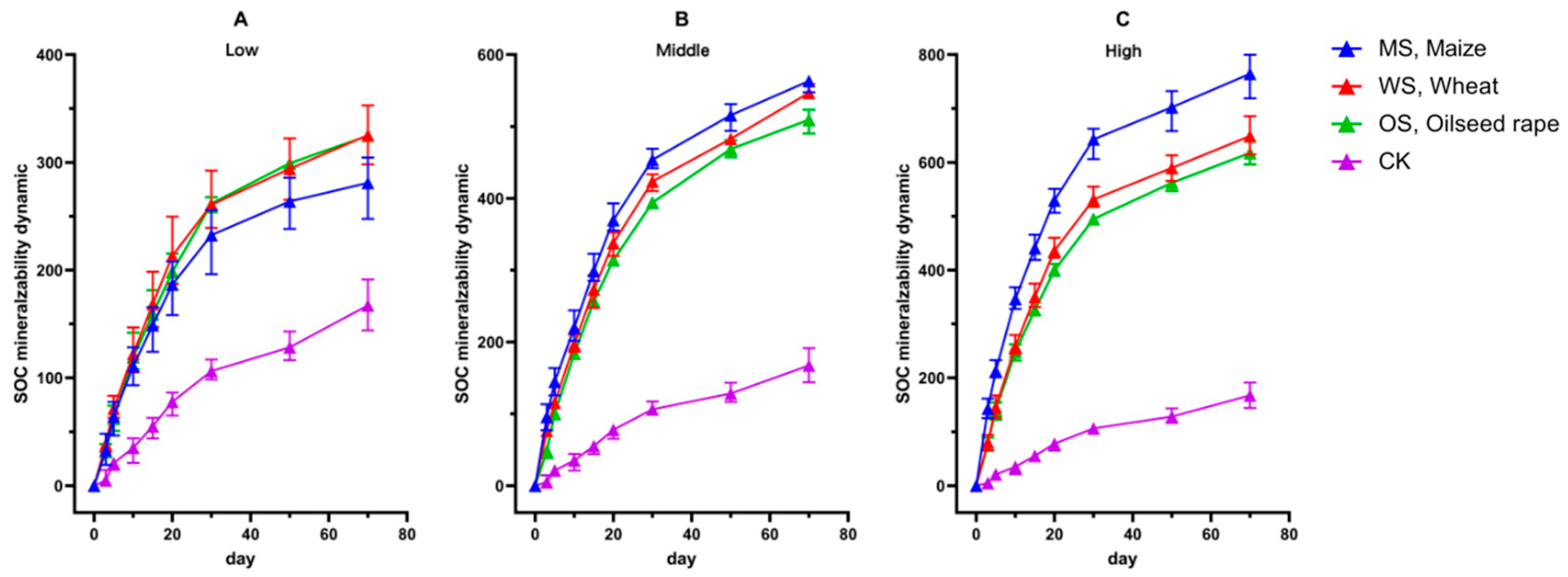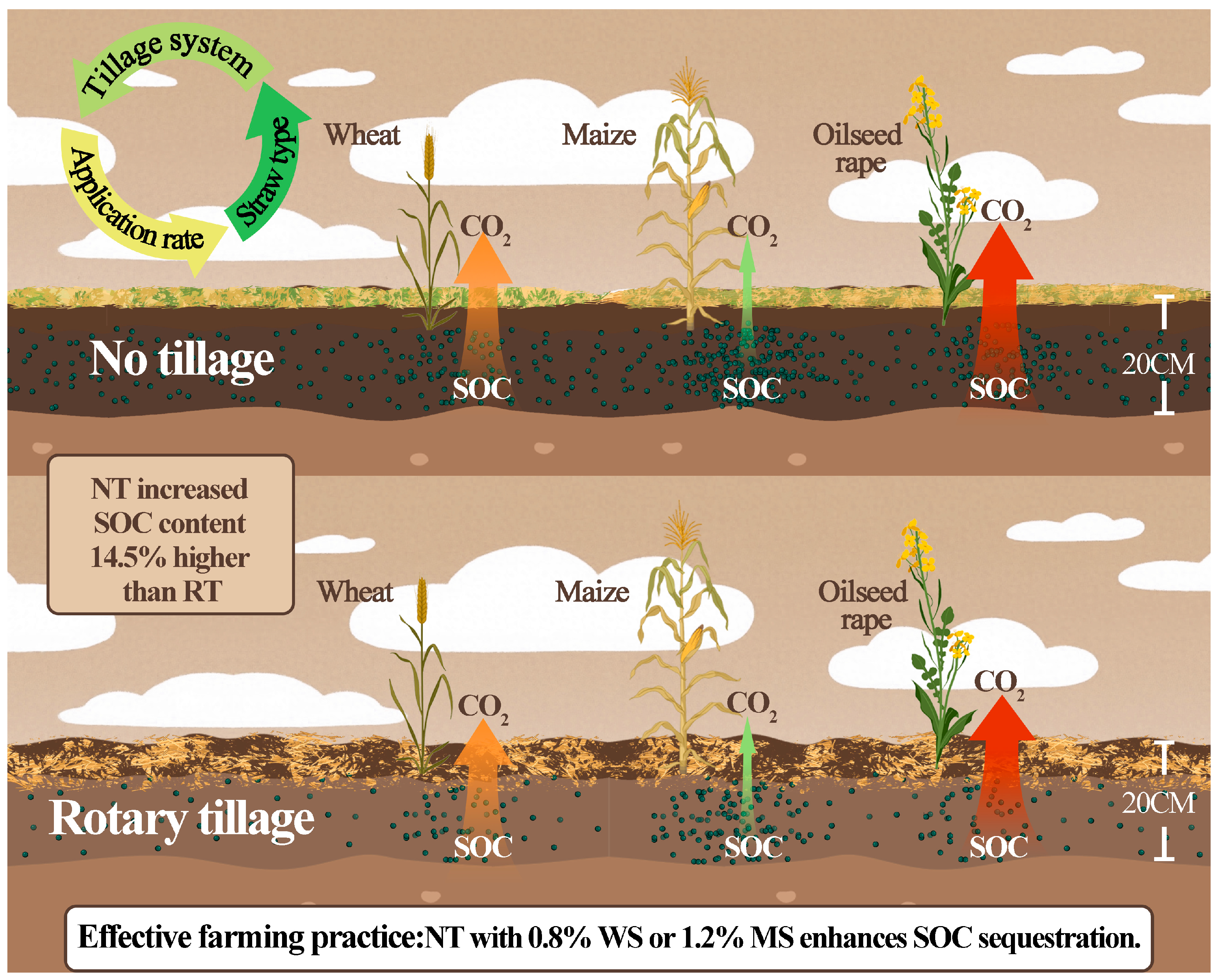1. Introduction
Soil organic carbon (SOC) serves as a crucial component of terrestrial carbon pools, playing a pivotal role in regulating global carbon cycling [
1] and atmospheric CO
2 concentrations [
2,
3]. Multiple factors, including climate conditions, soil properties, cropping systems, and agricultural practices, collectively influence SOC mineralization and stabilization processes, thereby directly determining carbon sequestration potential. Nevertheless, the intricate interactions that occur among tillage regimes, cropping systems, and straw return rates remain insufficiently quantified for single-cropping systems in eastern Inner Mongolia, which significantly hinders our understanding of SOC cycling mechanisms and the development of effective climate adaptation strategies. Conservation tillage practices, such as no tillage (NT), minimize soil disturbance and protect SOC. In contrast, rotary tillage (RT; a reduced tillage practice) can disrupt soil structure and accelerate SOC mineralization by increasing microbial access and aeration [
4]. Furthermore, straw incorporation serves as a primary source of external carbon input and significantly influences SOC dynamics [
5,
6]. Notably, the balance between SOC mineralization and stabilization under the addition of straw is highly sensitive to application rates [
7,
8]. However, key uncertainties persist regarding optimal straw management strategies for SOC sequestration.
Tillage practices affect SOC accumulation and mineralization as they alter the soil’s physical and chemical properties [
9]. Previous studies have shown that conventional tillage methods, such as RT, expose SOC to air, accelerating its mineralization and leading to SOC depletion [
10]. Conversely, conservation tillage practices, particularly NT, enhance surface SOC storage and stability by minimizing soil disturbance and retaining surface mulch [
11,
12]. The effects of tillage on SOC, however, are context-dependent. For example, in maize-upland rice systems, crop residue burning has been found to increase SOC levels [
13], while variations in fertilization methods also significantly regulate this process [
14]. Despite the fact that extensive research has been conducted on the effects of tillage, regional variations in soil properties, climate conditions, and cropping systems have yielded inconsistent conclusions, warranting further investigation. To address this gap, with this study, we specifically examine the complex interactions between tillage practices (NT or RT), straw types (maize, wheat, and oilseed rape), and application rates (low, medium, and high) in terms of SOC mineralization, aiming to provide more mechanistic insights beyond simple tillage comparisons.
Increasing straw return has been widely recognized as a key strategy that can be used to enhance SOC sequestration [
15,
16]. While higher annual straw inputs are commonly adopted to promote SOC accumulation [
17], the quantitative effects of application rates on SOC dynamics—particularly the existence of an optimal rate that maximizes sequestration efficiency—remain insufficiently understood across different tillage systems. Furthermore, different straw types exhibit varying SOC sequestration efficiencies due to their distinct chemical compositions and decomposition characteristics; however, their comparative roles in SOC stabilization are still poorly understood. Another critical research gap lies in the predominant focus on single management practices, which does not account for the potential synergies among three key factors: tillage (affecting straw placement and soil environment), straw type (determining inherent decomposability and sequestration potential), and application rate (controlling carbon input quantity). We hypothesized that significant synergistic interactions exist among tillage practices, straw types, and application rates, leading to divergent effects on SOC concentration and mineralization kinetics across treatment combinations; specifically, an optimal combination strategy (defined by specific tillage–straw–application rate pairing) would maximize the efficiency of SOC sequestration.
The Inner Mongolian Plateau is a major grain-producing region [
18], and it was an early adopter of conservation tillage in China [
19]. Characterized by a typical semi-arid agroecosystem with low temperatures and precipitation, its agricultural importance is growing due to climate change. However, our understanding of carbon dynamics under conservation tillage (e.g., NT and RT) combined with straw return (varying types and rates) remains particularly limited in such semi-arid regions compared to more studied temperate/subtropical zones, such as the North China and Northeast Plains. This knowledge gap hinders the development of effective carbon management strategies for these vulnerable ecosystems.
Based on a long-term conservation tillage experiment performed in the semi-arid agroecosystem of eastern Inner Mongolia, with this study, we aimed to evaluate the combined effects of tillage methods, straw return, and application rates on SOC mineralization and stabilization. To complement the long-term field observations and capture rapid response dynamics, a 70-day laboratory incubation was performed. The specific objectives of this study were as follows:
- (1)
Quantify tillage effects on surface soil (0–20 cm) SOC content and mineralization rates;
- (2)
Characterize the impacts of straw type and application rates on SOC mineralization;
- (3)
Assess the interactive effects of straw application rates, tillage practices, and straw types on SOC dynamics and mineralization.
2. Materials and Methods
2.1. Experimental Design
This study was performed as part of a long-term conservation tillage experiment initiated in 2017 and sampled in 2024 (a 7-year period) in Arongqi County (47°56′ N, 122°09′ E), Hulunbuir City, within China’s Inner Mongolia Autonomous Region. This region has a temperate continental monsoon climate, with historical averages (1957–2021) from the Arongqi Meteorological Bureau [
20] showing the following: 624 mm annual precipitation, 2 °C mean annual temperature, and 2700 °C accumulated temperature (≥10 °C). The agricultural system follows a single-cropping pattern annually, with wheat, maize, and oilseed rape as the primary crops. Located in the southern Great Khingan Mountains, Arongqi County represents a significant agricultural production area in eastern Inner Mongolia [
21], where these dominant crops generate substantial straw resources suitable for return practices [
22,
23].
To assess the straw input effects, a 70-day laboratory soil incubation experiment was performed. Based on the actual field practice conversions, three straw application rate gradients were established: 0.4% (low, L), 0.8% (medium, M), and 1.2% (high, H) [
24,
25,
26]. The experimental design incorporated three factors: tillage methods: No tillage (NT) and rotary tillage (RT); crop straw types: Maize straw (MS), wheat straw (WS), and oilseed rape straw (OS); and straw addition rates: 0.4% (L), 0.8% (M), and 1.2% (H) by mass ratio on a dry mass basis (
Table 1). This factorial arrangement resulted in eighteen treatment combinations, with three time replications. For each tillage method, we included a control treatment (CK) without straw return, using 30 g of dry soil as a blank reference. We also used empty incubation bottles containing only the NaOH solution (without soil or straw) to quantify and correct for background CO
2 absorption from the atmosphere during the bottle handling procedures (e.g., when opening bottles to remove samples or replace NaOH traps).
2.2. Soil Sampling
Soil samples were collected in October 2024 following crop harvest from the 0 to 20 cm soil layer. In the laboratory, visible plant residues and stones were manually removed. The samples were air-dried at room temperature, gently crushed, and passed through a 2 mm sieve to ensure homogeneity before being stored in sealed containers at room temperature until they were used for analysis. The soil in the study area is classified as Luvisol (FAO), dark brown earth (Chinese Soil Taxonomy), with a USDA texture classification of loam (sand/silt/clay = 40:35:25).
Prior to the experiment, soil samples from the 0 to 20 cm plow layer were analyzed to determine their basic physicochemical properties (
Table 2). The soil water content and maximum field water-holding capacity were measured using the gravimetric method. The total nitrogen content was determined using the Kjeldahl method, and the SOC concentration was analyzed via dichromate oxidation (K
2Cr
2O
7-H
2SO
4 system).
Air-dried maize, wheat, and oilseed rape straw, sourced from the same field, were roughly ground and sieved through a 2 mm mesh sieve.
2.3. Laboratory Incubation
All soil samples were adjusted to 70% of their maximum field water-holding capacity. For different treatments, straw was added to 30 g dry soil samples under both NT and RT conditions. In the NT treatments, straw was evenly spread on the soil surface (an approximately 0.5 cm thick layer), and it was not mixed. For the RT treatments, straw and soil were thoroughly homogenized using a sterile glass rod. The prepared soil samples were then sealed in airtight incubation bottles. All of the bottles were placed in an incubator maintained at 25 °C with 15% relative humidity for a one-week pre-incubation period. This pre-incubation period allowed for the soil microbial communities to acclimatize to the experimental conditions, ensuring that we collected more precise and consistent results in the subsequent measurements.
Following the pre-incubation period, the samples were incubated at 25 °C for 70 days. Each bottle contained a 10 mL beaker with 10 mL of 1 M NaOH solution to trap CO2 that was released during the incubation. On days 3, 5, 10, 15, 20, 30, 50, and 70 of the experiment, the NaOH-containing beakers were removed from the bottles so that they could undergo analysis. The CO2 released from the soil (indicating mineralization) was quantified using hydrochloric acid back-titration. The results were expressed as CO2-C emissions per kg of organic carbon (SOCam mg CO2-C/kg soil).
2.4. Measurement of SOC Content and Mineralization
2.4.1. SOC Content
The SOC content was determined using the Walkley–Black method following the standard protocol (Walkley & Black, 1934). Air-dried soil samples sieved to <0.15 mm (0.2 g) were digested with K2Cr2O7-H2SO4 at 210 °C for 5 min and then titrated with FeSO4. The SOC concentration (g/kg) was calculated after the blank correction.
2.4.2. SOC Mineralization
The NaOH absorption back-titration method was used to determine SOC mineralization. For the 30 g soil sample under cultivation, a beaker containing 20 mL of 1 mol/L NaOH solution was placed on a rack. On the nth day of mineralization incubation, the NaOH absorption solution was taken out, and 1 mL of 1 mol/L BaCl2 solution was added to the absorption solution to precipitate CO32− as BaCO3. After it was left to stand, 2–3 drops of phenolphthalein indicator were added, and the solution was titrated with 0.2 mol/L HCl until the red color disappeared. The amount of CO2 released was calculated based on the difference in HCl consumption between the blank group and the sample group, and the cumulative organic carbon mineralization amount (mg C/g) was obtained.
2.5. Data Calculation
Soil organic carbon (SOC) mineralization was achieved through NaOH-trapped CO2 back-titration with HCl. Cumulative mineralization (CN) was calculated by adding up the daily mineralization values (CN) over time. Specific mineralization (SOCpm) was found via normalizing the absolute mineralization (SOCam) to the soil SOC concentration.
Mineralization dynamics were modeled using a first-order kinetic equation:
where C
N is the cumulative mineralization amount of organic carbon after time t (mg C/kg soil); C
p is the carbon amount with the potential to be mineralized; and K0 is a fixed-rate constant for decomposition. The two unknown quantities (C
p and K0) were estimated using SPSS 27.0 (SPSS Inc., Chicago, IL, USA). The complete calculation procedures are provided in the
Supplementary Materials (cites references [
27,
28]).
2.6. Statistical Analysis
Experimental data were processed and analyzed using Microsoft Office 2024 software and SPSS 27.0 software. Three-way analysis of variance (ANOVA) was performed using SPSS 27.0 to elucidate the impacts of each treatment (tillage methods, crop straw types, and straw addition rates) on the cumulative amount of SOC mineralization. When the significance level was set at p < 0.05, Tukey’s method was used to conduct multiple comparisons of the means among different treatments, aiming to identify whether significant differences existed among the treatment groups. We also conducted first-order kinetic model fitting to obtain the mineralization rate using SPSS 27.0. Moreover, GraphPad Prism 9.5 software was used to visualize the experimental data and generate relevant charts, thereby intuitively presenting the experimental results for the analysis and discussion.
5. Conclusions
With this study, we investigated the combined effects of tillage methods, straw types, and application rates on the dynamics and mineralization of soil organic carbon (SOC) using controlled laboratory experiments. In the 0–20 cm soil layer, no tillage (NT) significantly increased the SOC concentration—by 0.81% to 13.47% compared to rotary tillage (RT)—with the greatest difference observed in the treatments without straw return.
Under NT, the SOC concentration after wheat straw return was significantly higher than that after maize and oilseed rape straw return, while under RT, the SOC concentration after oilseed rape straw return was significantly lower than that after maize and wheat straw return. At low straw application rates (0.4%), oilseed rape straw exhibited the highest specific SOC mineralization rate (33.9%) compared to maize and wheat. Absolute SOC mineralization increased significantly with the straw addition rates, with mineralization at high straw application rates (1.2%) increasing by 40.2–61.8% (NT) and 26.8–41.2% (RT) compared to that at medium and low rates.
In the semi-arid agroecosystems of eastern Inner Mongolia, combining no tillage (NT) with 0.8% wheat straw or 1.2% maize straw increased the SOC concentration by 12–18%, representing the optimal carbon sequestration strategy under low annual precipitation and cool conditions. This strategy can be adapted according to local cropping systems: wheat-producing areas should prioritize 0.8% wheat straw return; maize-growing areas should adopt 1.2% maize straw return; and we recommend that oilseed rape areas combine straw return with rotary tillage to achieve moderately rapid decomposition and minimize carbon loss. Adopting these tailored strategies not only results in carbon storage being enhanced, but can also reduce costs (e.g., fewer tillage passes) and support stable crop yields over time by improving soil health. Through our findings, we have delivered targeted solutions for the management of SOC in semi-arid agricultural regions, addressing the precipitation deficits that are characteristic of such ecosystems.
